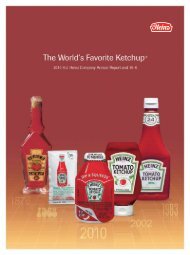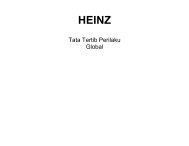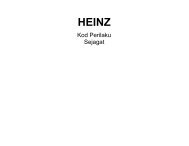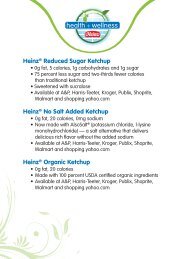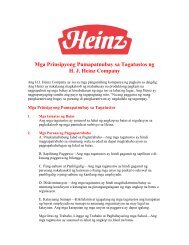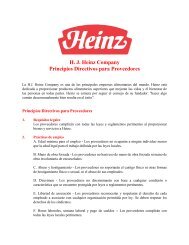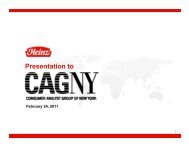Download Annual Report PDF - Heinz
Download Annual Report PDF - Heinz
Download Annual Report PDF - Heinz
Create successful ePaper yourself
Turn your PDF publications into a flip-book with our unique Google optimized e-Paper software.
At April 27, 2011, the Company had total debt of $4.61 billion (including $151 million relating to<br />
the hedge accounting adjustments) and cash and cash equivalents and short-term investments of<br />
$784 million. Total debt balances have decreased slightly since prior year end due to the items<br />
discussed above. The Company is currently evaluating alternatives for the refinancing and/or<br />
retirement of the $1.45 billion of long-term debt maturing in Fiscal 2012. On May 26, 2011,<br />
subsequent to the fiscal year end, the Company issued $500 million of private placement notes at<br />
an average interest rate of 3.48% with maturities of three, five, seven and ten years. The proceeds will<br />
be used to partially refinance debt that matures in Fiscal 2012.<br />
At April 27, 2011, approximately $600 million of cash and short-term investments was held by<br />
international subsidiaries whose undistributed earnings are considered permanently reinvested.<br />
Our intent is to reinvest these funds in our international operations and our current plans do not<br />
demonstrate a need to repatriate them to fund our U.S. operations. If we decided at a later date to<br />
repatriate these funds to the U.S., the Company would be required to provide taxes on these amounts<br />
based on the applicable U.S. tax rates net of foreign taxes already paid.<br />
At April 27, 2011, the Company had a $1.2 billion credit agreement which expires in April 2012.<br />
This credit agreement supports the Company’s commercial paper borrowings. As a result, the<br />
commercial paper borrowings at April 28, 2010 are classified as long-term debt based upon the<br />
Company’s intent and ability to refinance these borrowings on a long-term basis. There were no<br />
commercial paper borrowings outstanding at April 27, 2011. The credit agreement has customary<br />
covenants, including a leverage ratio covenant. The Company was in compliance with all of its<br />
covenants as of April 27, 2011 and April 28, 2010. In June 2011, the Company expects to modify the<br />
credit agreement to increase the available borrowings under the facility to $1.5 billion as well as to<br />
extend its maturity date to 2016. In anticipation of these modifications, the Company terminated a<br />
$500 million credit agreement during April 2011. In addition, the Company has $439 million of<br />
foreign lines of credit available at April 27, 2011.<br />
After-tax return on invested capital (“ROIC”) is calculated by taking net income attributable to<br />
H.J. <strong>Heinz</strong> Company, plus net interest expense net of tax, divided by average invested capital.<br />
Average invested capital is a five-point quarterly average of debt plus total H.J. <strong>Heinz</strong> Company<br />
shareholders’ equity less cash and cash equivalents, short-term investments, restricted cash, and the<br />
hedge accounting adjustments. ROIC was 19.3% in Fiscal 2011, 17.8% in Fiscal 2010, and 18.4% in<br />
Fiscal 2009. Fiscal 2011 ROIC was unfavorably impacted by 40 basis points as a result of the<br />
Coniexpress acquisition. Fiscal 2010 ROIC was negatively impacted by 90 basis points for the losses<br />
on discontinued operations. The increase in ROIC in Fiscal 2011 compared to Fiscal 2010 is largely<br />
due to higher earnings and reduced debt levels partially offset by higher equity reflecting the impact<br />
of cumulative translation adjustments. ROIC in Fiscal 2009 was favorably impacted by 110 basis<br />
points due to the $107 million gain on foreign currency forward contracts discussed earlier. The<br />
remaining increase in Fiscal 2010 ROIC compared to Fiscal 2009 is largely due to reduced debt levels<br />
and effective management of the asset base.<br />
The Company will continue to monitor the credit markets to determine the appropriate mix of<br />
long-term debt and short-term debt going forward. The Company believes that its strong operating<br />
cash flow, existing cash balances, together with the credit facilities and other available capital<br />
market financing, will be adequate to meet the Company’s cash requirements for operations,<br />
including capital spending, debt maturities, acquisitions, share repurchases and dividends to<br />
shareholders. While the Company is confident that its needs can be financed, there can be no<br />
assurance that increased volatility and disruption in the global capital and credit markets will not<br />
impair its ability to access these markets on commercially acceptable terms.<br />
25





